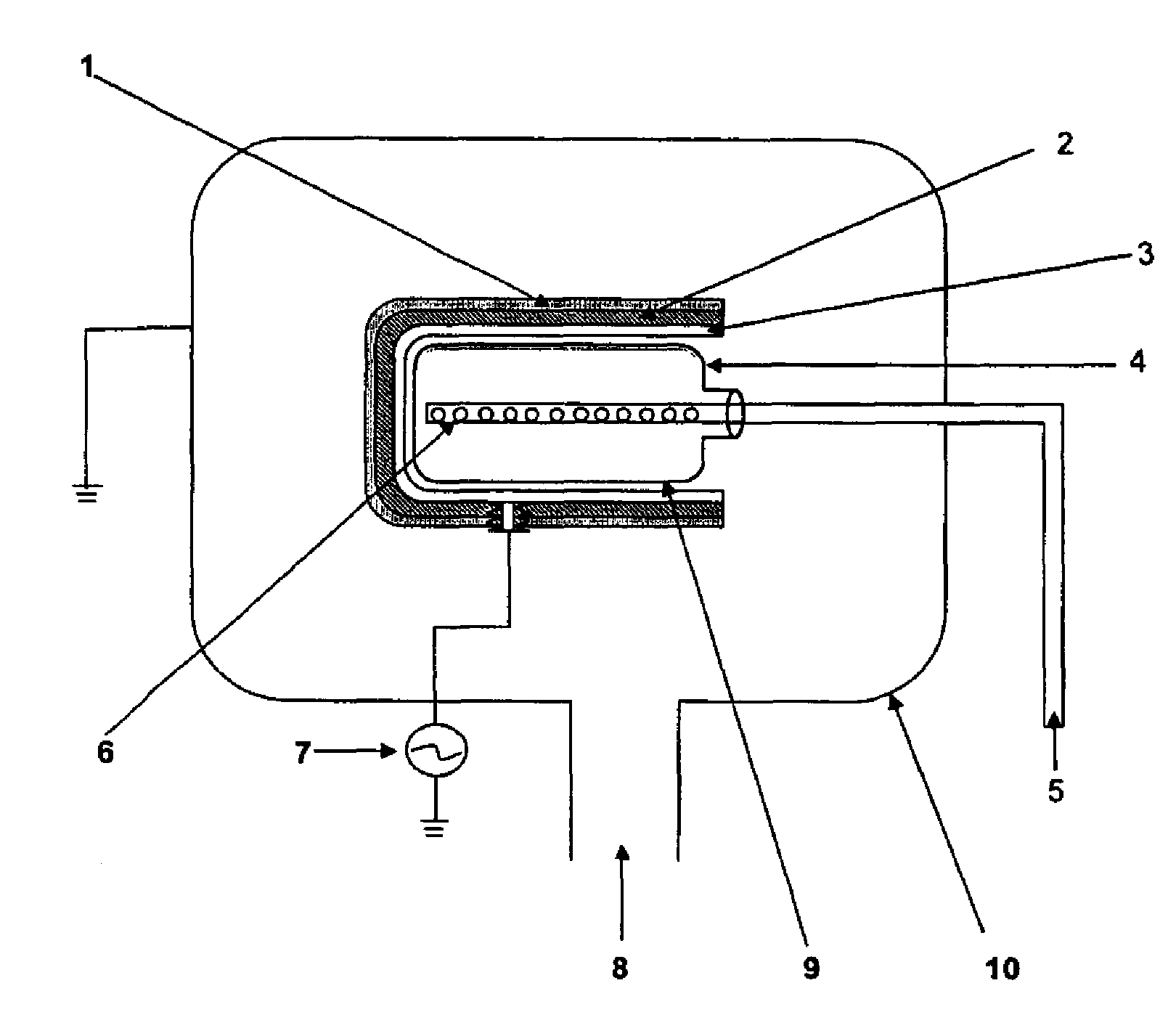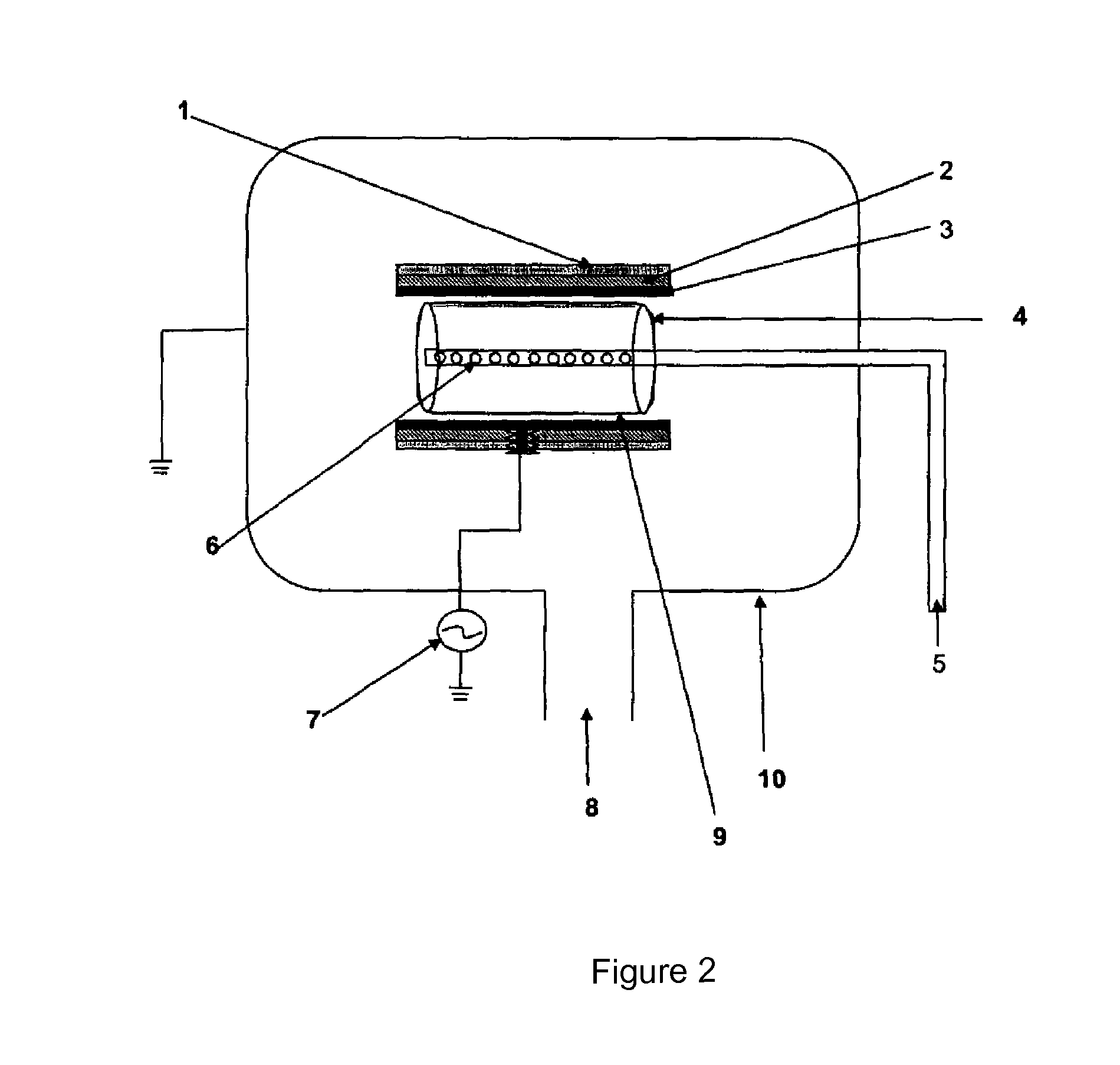Process to deposit diamond like carbon as surface of a shaped object
a diamond-like carbon and surface technology, applied in the field of improvement, can solve the problems of low adhesion strength, limited practical application of dlc films, and low thermal stability of dlc films
- Summary
- Abstract
- Description
- Claims
- Application Information
AI Technical Summary
Benefits of technology
Problems solved by technology
Method used
Image
Examples
example-1
[0079]In one deposition several pieces of glass substrate (area ˜1.0 cm2 each) were properly cleaned by adopting standard procedures and placed on the cathode in the hollow cathode capacitively coupled PECVD chamber and the chamber was pumped to a base pressure better than le Ton using turbo pump backed by rotary pump. Actually the substrates were placed on hollow cylindrical shaped powered electrode. The source gas acetylene was let into the chamber through mass flow controllers. The acetylene flow rate of 10 sccm was maintained during the process. The chamber pressure was maintained at 25 mtorr using baratron and throttle valve and their controllers. The radio frequency (13.56 MHz) discharge was created by applying the power density of ˜150 mW / cm2 to cathode, corresponding self bias was −150V. The film was deposited at a rate of 0.2 A0 / sec and for this film hardness and stress values were found to be 8 GPa and 0.2 GPa, respectively.
example-2
[0080]In another deposition several plastic sheets (area ˜1.0 cm2 each) were cleaned; placed on hollow cylindrical shaped cathode (the power electrode) in the system and the system was pumped to a base pressure better than 10−5 Torr. There was no deliberate heating of the substrate. The source gas acetylene was let into the chamber through mass flow controller. The acetylene (C2H2) flow rate of 20 sccm was maintained during the process. The chamber pressure was maintained at 25 mTorr using baratron and throttle valve and their controllers. The radio frequency (13.56 MHz) discharge was created by applying the power density 150 mW / cm2 to cathode. The film was deposited at same rate observed in example 1. There was no delamination observed in the film.
example-3
[0081]In another deposition several pieces of glass, silicon wafer, plastic (area ˜1.0 cm2 each) substrates were cleaned and placed on hollow cylindrical shaped cathode in the chamber and the chamber was pumped to a base pressure better than 10−5 torr. There was no deliberate heating of the substrates. The source gas acetylene (C2H2) was let into the chamber through mass flow controller. The silane flow rate of 20 sccm and argon partial pressure of 20% was maintained during the process. The chamber pressure was maintained at 25 mtorr using baratron and throttle valve and their controllers. The radio frequency (13.56 MHz) discharge was created by applying the power density 200 mW / cm2 to cathode. The film was deposited at a rate of 3.3 A0 / sec and for this film value of hardness was found to be 12 GPa. There was no delamination observed in the film.
EXAMPLE-3 (a)
[0082]In another deposition several pieces of glass, silicon wafer, and plastic (area ˜1.0 cm2 each) substrates were cleaned a...
PUM
| Property | Measurement | Unit |
|---|---|---|
| radio frequency | aaaaa | aaaaa |
| temperature | aaaaa | aaaaa |
| thickness | aaaaa | aaaaa |
Abstract
Description
Claims
Application Information
 Login to View More
Login to View More - R&D
- Intellectual Property
- Life Sciences
- Materials
- Tech Scout
- Unparalleled Data Quality
- Higher Quality Content
- 60% Fewer Hallucinations
Browse by: Latest US Patents, China's latest patents, Technical Efficacy Thesaurus, Application Domain, Technology Topic, Popular Technical Reports.
© 2025 PatSnap. All rights reserved.Legal|Privacy policy|Modern Slavery Act Transparency Statement|Sitemap|About US| Contact US: help@patsnap.com



